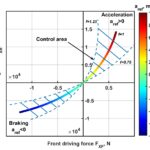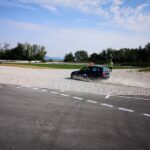
Miha Ambrož, Jovan Trajkovski, Robert Kunc
Transportation Research Procedia 69 (2023) 592–599
Abstract
Motorways are usually perceived as the safest part of the road infrastructure. Nevertheless, the junctions and exit ramps on them can still present a safety challenge due to high average velocities and obstacles installed to contain the out-of-control vehicles within the roadway. Recently, the gravel arrester-beds have been constructed on many locations on motorway junctions and exit ramps. They present a viable alternative to the rigid barriers and deformable crash-cushions normally used on these locations. They help decelerate the vehicles by dissipating the kinetic energy in the gravel bed and thus stop the vehicles more gradually on a longer distance, causing lower average decelerations and thus reducing passenger injuries. Furthermore, by proper design, they can reduce the damage sustained by the vehicles and the infrastructure and thus shorten the times required to re-open roads after incidents. The paper provides an insight into the subject and presents some recent findings obtained from measurements on a test site, and from simulations with different types of vehicles. The parameters and their required values for optimizing the efficiency of gravel arrester beds for different requirements are discussed in the final part.








